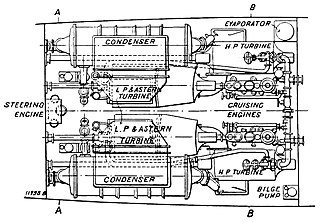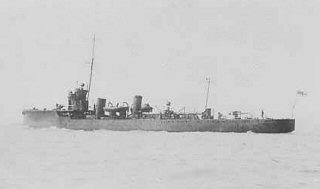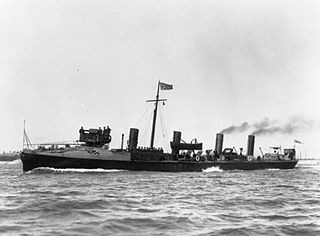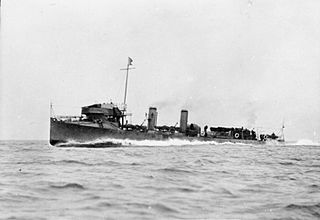This article includes a list of references, related reading, or external links, but its sources remain unclear because it lacks inline citations .(January 2010) |
In the Royal Navy there have been a variety of naming conventions for destroyers.
This article includes a list of references, related reading, or external links, but its sources remain unclear because it lacks inline citations .(January 2010) |
In the Royal Navy there have been a variety of naming conventions for destroyers.
Destroyers were originally developed as a defence against torpedo boats, and the first torpedo boat destroyer (TBD) in the Royal Navy was HMS Havock of 1893. From 1906, the term "torpedo boat destroyer" began to appear in the shortened form "destroyer" when referring to destroyer flotillas. There is no official Admiralty order pertaining to the change and the abbreviated term "TBD" is present in the Navy List up to 1919, even though destroyer was the term used in most official orders from 1917.
Up to 1913, names were allocated under no fixed system, leading to a heterogeneous array, although two groups were named systematically; after rivers and tribes (later the E and F classes, respectively). In 1913, with burgeoning numbers of TBDs, the Admiralty took the confusing situation in hand; Havock and her similar "27 knotter" sisters with two shafts were grouped as the A class, and similar groups of "30 knotter" TBDs were grouped as the B class (four-funneled ships), C class (three funnels) and D class (two funnels). Later classes of ships were grouped as the E to K classes, although there was no J class. These are ships that the observer would recognize as being the forerunners of the modern destroyer, with the turtleback and low conning tower replaced by a forecastle and wheelhouse with a compass platform above.
The last class of ships built with mixed names were the Acasta or K class of the 1911–1912 program. From the L class of the 1912–1913 program onwards, ships took the initial letter of their name from the class letter, although large classes such as the M, R, and S were allocated more than one initial letter. Flotilla leaders were generally named after famed historical (and generally, naval) characters and vessels building for other countries that had been commandeered for the Royal Navy were not allocated into the letter system (e.g. ex-Turkish ships received "T" names and ex-Greek ships "M" names with a Greek mythology theme).
Post war, flotillas were ordered as eight ships and a separate leader (later seven ships and a leader, later eight ships and no specialised leader). Each class was allocated an initial letter from which names were taken, and leaders were again often named after historical figures. These ships, up to the I class, are known as the "interwar standard". Again, vessels appropriated from other nations were not allocated into the class letter system, but took letter names of similar Royal Navy designs.
The programme of 1936 produced sufficiently novel ships to warrant a change in convention; "tribal" names again being applied, although subsequent ships returned to the letter system. The O through Z classes were ordered under the War Emergency Programme. Having exhausted the alphabet, the next emergency flotillas returned to the next unused letter start of the alphabet. This was C, the C class of 1930 having been completely transferred to the Royal Canadian Navy. As five flotillas were ordered, groups of two initial letters were used; Ca-, Ch-, Co-, Cr- and Ce-, although the latter flotilla was later cancelled.
The proposed G class of 1943 were the penultimate ships to be allocated letter names, after this systematic themes for names were adopted; Battles, Weapons, Counties and Towns. The exception was the Daring class of 1949 with names beginning with D. Since the County class of 1959, type numbers have also been allocated to destroyers.
The Type 45 destroyers, the Royal Navy's latest vessels of this type, have resurrected the letter naming convention, taking D names, and repeating some of the previous Daring class. [1]

In naval terminology, a destroyer is a fast, maneuverable, long-endurance warship intended to escort larger vessels in a fleet, convoy, or carrier battle group and defend them against a wide range of general threats. They were originally conceived in 1885 by Fernando Villaamil for the Spanish Navy as a defense against torpedo boats, and by the time of the Russo-Japanese War in 1904, these "torpedo boat destroyers" (TBDs) were "large, swift, and powerfully armed torpedo boats designed to destroy other torpedo boats". Although the term "destroyer" had been used interchangeably with "TBD" and "torpedo boat destroyer" by navies since 1892, the term "torpedo boat destroyer" had been generally shortened to simply "destroyer" by nearly all navies by the First World War.

A ship class is a group of ships of a similar design. This is distinct from a ship type, which might reflect a similarity of tonnage or intended use. For example, USS Carl Vinson is a nuclear aircraft carrier of the Nimitz class.
In the Royal Navy and other navies of Europe and the Commonwealth of Nations, ships are identified by pennant number. Historically, naval ships flew a flag that identified a flotilla or type of vessel. For example, the Royal Navy used a red burgee for torpedo boats and a pennant with an H for torpedo boat destroyers. Adding a number to the type-identifying flag uniquely identified each ship.

The Havock class was a class of torpedo boat destroyer (TBD) of the British Royal Navy. The two ships, Havock and Hornet, built in London in 1893 by Yarrow & Company, were the first TBDs to be completed for the Royal Navy, although the equivalent pair from J.I. Thornycroft, Daring and Decoy, were ordered five days earlier.

The Laforey class was a class of 22 torpedo boat destroyers of the Royal Navy, twenty of which were built under the Naval Programme of 1912–13 and a further two under the 2nd War Emergency Programme of 1914. As such they were the penultimate pre-war British destroyer design. All served during World War I during which three were lost; the survivors were all scrapped in 1921-23.

The A class as designated in 1913 was a heterogeneous group of torpedo boat destroyers (TBDs) built for the Royal Navy in the mid-1890s. Some 42 vessels were constructed to the individual designs of their builders to meet Admiralty specifications, the only uniting feature being a specified top speed of 27 knots (50 km/h). In fact the initial six vessels were generally differentiated by a slightly lower speed and were often referred to as "26-knotters" to distinguish them from the following batch of thirty-six vessels; all fifteen surviving "27-knotter" vessels were classified by the Admiralty as the A class in 1913 to provide some system to the naming of HM destroyers. All of the "26-knotters" and most of the "27-knotters" had been lost or scrapped before the 1913 classification, but for convenience all 42 ships are listed below. The number of funnels varied from one to four. All vessels had a distinctive "turtleback" forecastle that was intended to clear water from the bow, but actually tended to dig the bow in to anything of a sea, resulting in a very wet conning position.

The D class as they were known from 1913 was a fairly homogeneous group of torpedo boat destroyers (TBDs) built for the Royal Navy in the mid-1890s. They were all constructed to the individual designs of their builder, John I. Thornycroft & Company of Chiswick, to meet Admiralty specifications. The uniting feature of the class was a top speed of 30 knots and they all had two funnels.

The Acasta class was a class of twenty destroyers built for the Royal Navy under the Naval Programme of 1911 - 1912 that saw service during World War I. They were the last class of Royal Navy destroyers to have mixed names with no systematic theme When the class was designated as "K", names beginning with that letter were allocated to the ships but never used. The class saw extensive wartime service and seven were lost, including four at the Battle of Jutland.

The S class was a class of 67 destroyers ordered for the Royal Navy in 1917 under the 11th and 12th Emergency War Programmes. They saw active service in the last months of the First World War and in the Russian and Irish Civil Wars during the early 1920s. Most were relegated to the reserve by the mid-1920s and subsequently scrapped under the terms of the London Naval Treaty. Eleven survivors saw much action during the Second World War.

The Viper class was a group of two torpedo boat destroyers built for the British Royal Navy in 1899.

The Acheron class was a class of twenty-three destroyers of the British Royal Navy, all built under the 1910–11 Programme and completed between 1911 and 1912, which served during the First World War. A further six ships were built to the same design for the Royal Australian Navy as River-class destroyers. There was considerable variation between the design and construction of ships within this class, which should be considered as more of a post-build grouping than a homogeneous class.

HMS Express was a B-class torpedo boat destroyer of the British Royal Navy. She was completed by Laird, Son & Company, Birkenhead, in 1896. Like many contemporary British destroyers, she was a "builder's special", designed to Admiralty specifications but built to the builder's own design.

HMS Hornet was a Havock-class torpedo boat destroyer of the British Royal Navy. She was launched in 1893 and sold in 1909 for scrapping. Although the Daring-class torpedo boat destroyers were ordered first, Havock and Hornet were completed faster, making them the first destroyers ever built.

Two Daring-class destroyers were the very first torpedo boat destroyers ("TBDs") to be ordered for the Royal Navy, the order being placed on 27 June 1892.

Two Ferret-class destroyers served with the Royal Navy. Ferret and Lynx were built by Laird, displaced 280 tons and were 199 feet (61 m) in overall length.

The three Ardent-class torpedo boat destroyers were ordered by the British Admiralty on 12 October 1893 and served with the Royal Navy. Built by Thornycroft for a contract price of £110,520 for all three vessels, they displaced 301 tons fully laden, and were 201 feet 8 inches (61.47 m) long overall.

The Cricket class and following classes of coastal destroyers were a series of small torpedo boat destroyers (TBDs) intended to complement the Royal Navy's Tribal-class destroyers. The thirty-six vessels which broadly comprised this group actually consisted of several distinct classes, as each contractor built to their own designs, and even single contractor's designs evolved from year to year.

HMS Sunfish was a "twenty-seven knotter" torpedo boat destroyer of the British Royal Navy. Built by the Tyneside shipbuilder Hawthorn Leslie, Sunfish was one of three destroyers built by Hawthorns that year. She was sold for scrap in 1920.

HMS Linnet was a Laforey-class destroyer that served with the Royal Navy during the First World War. Launched on 16 August 1913 as HMS Havock, the ship was renamed on 30 September under an Admiralty order to become one of the first destroyers in a class named alphabetically. This convention subsequently became the norm. On commissioning, the vessel joined the Third Destroyer Flotilla and operated as part of the Harwich Force. The destroyer was first commanded by Commander Loftus Jones who named his daughter Linnette after the ship. During the War, the destroyer took part in the Battle of Heligoland Bight in 1914, and escorted minelayers on missions to lay mines. It was during one the latter missions that the ship was nearly hit by a gun hurled from the stricken minelayer Amphion. With the cessation of hostilities, the ship was placed in reserve and sold to be broken up on 4 November 1921.